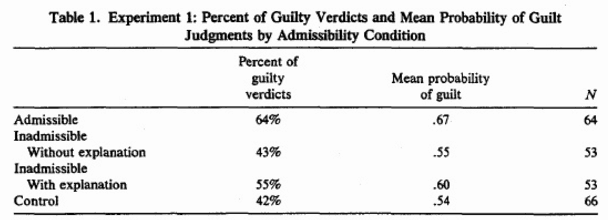Pickel, K.L. (1995) ‘Inducing Jurors to Disregard Inadmissible Evidence: A Legal explanation Does not help. Law and Human Behaviour. Volume 19, Issue 4.
Background
This is the third study we will be looking at from Reaching Verdict and Persuading a Jury, as part of your OCR A2 Forensic Psychology course. It is further categorised into ‘inadmissible evidence.’
Reaching a verdict and Persuading a Jury consider the legal system. This study specifically covers the effects of evidence being ruled as inadmissible.
Hovland and Janis (1959) – proposed the Yale Model of Persuasion, which suggests that there are a number of factors to consider when attempting to persuade an audience.
They proposed four factors:
- Source
- Message
- Recipients
- Situation
The Source of the message must appear credible and non-biased.
The message must have some emotional appeal and the most important information should be presented first.
The recipient’s resistance to persuasion is important and this can be reduced by making the situation more informal.
The situation can be made more informal by the use of jokes, eye contact and using the audiences’ first names.
Aim
This study had three aims:
- To study the effects of prior convictions on jury verdicts.
- To study the role of the judge’s instructions when they were followed by a legal explanation.
- To examine how much the credibility of the witness affects the juror’s ability to ignore inadmissible evidence.
Method and Design
A laboratory experiment of a mock trial of a fictional theft with a mock jury.
Participants were randomly assigned using an independent measures design.
The participants were aware that this was a mock trial.
Participants
236 Psychology students from Bali State University (Indiana, U.S.A).
The students were required to participate as part of their course requirement.
Procedure
On arrival, the participants listened to an audiotape of the trial, which contained a piece of critical evidence. The critical evidence was information about a prior conviction of the defendant’s, which therefore favoured the prosecution team.
The critical piece of evidence was a prior conviction of the defendant.
The item was objected to by the attorney of the defence team. The conditions varied at this point, some participants would hear the judge allow the evidence and the others would hear it disallowed.
When the jurors were instructed to ignore the inadmissible evidence this ruling was sometimes supported with a legal explanation. The judge would express that the evidence should be disregarded as it might be suggestive of bad character and bias the jury members . In one of the conditions no legal explanation was given when the evidence was ruled as inadmissible.
Participants were then asked to complete a questionnaire asking them to make several decisions about the case:
- Verdict: Guilty or not guilty
- Estimate the probable guilt of the defendant
- State how much the knowledge of the prior conviction caused them to believe the defendant was guilty on a scale of 1 to 10.
- Give a rating of the credibility of each witness.
Findings

Conclusions
Calling attention to inadmissible evidence makes it more important to the jury and they pay more attention to it. This has some real life application as it is a tactic that could be used by prosecution and defence to draw attention to specific pieces of evidence, which may confound upon the juror’s verdict despite being ruled as inadmissible.
Pickel (1995) Evaluation
– Ecological validity – the participants knew it was a mock trial.
– Validity – arguably, this study is low in validity as the third question on the question is a leading question.
– Qualitative Data – the lack of qualitative data in this study does not provide us with any detail with which we can further understand that juror’s verdicts.
+ Reliability – both the large sample and the methodology makes this experiment highly reliable.
– Demand Characteristics – As the participants were given course credit for their participation, we can argue that some of the results may be due to participants trying to act in a way desirable to the experimenters.
– Ethnocentrism – the study only used American Psychology students. This is not a representative sample and therefore cannot be generalised to other countries or even the legal system in the USA.
+ Quantitative Data – The quantitive data is easy to compare and analyse, which makes it easy to establish cause and effect through statistical significance.
Audio Podcast
References
Further Reading
OCR A2 Psychology Student Unit Guide: Unit G543: Forensic Psychology (Student Unit Guides)
You have taken out the wrong table from the study. You have taken it from exp 2 by mistake, thats why the conclusion does’t make sense. The one you need is titled
PICKEL
Table 1. Experiment 1: Percent of Guilty Verdicts and Mean Probability of Guilt Judgments by Admissibility Condition
Thank you for pointing that mistake out. I have now fixed this issue.
Thanks
Psych Yogi